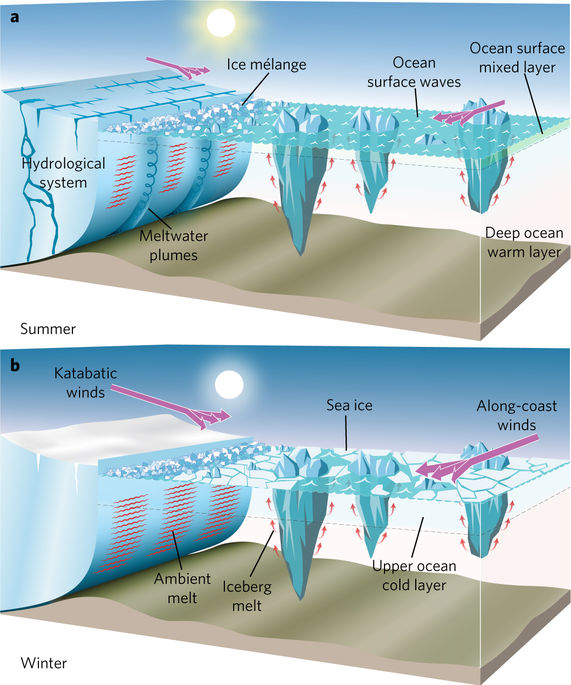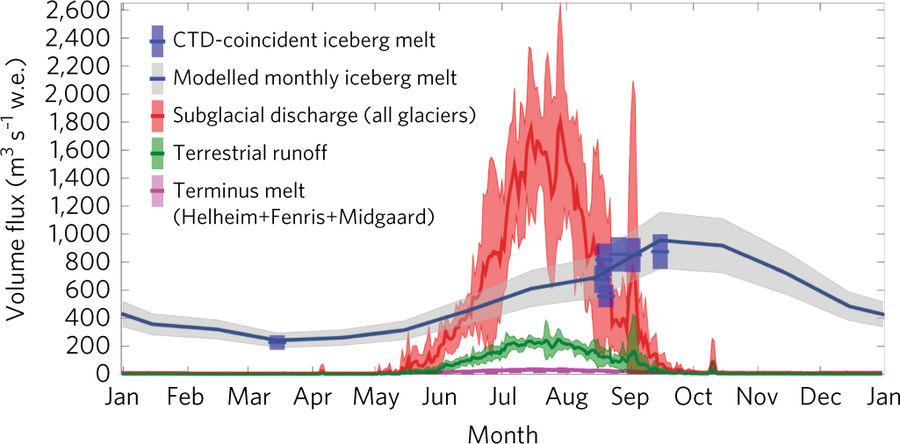Paper: T. Moon, et al., 2017. Subsurface iceberg melt key to Greenland fjord freshwater budget. Nature Geoscience, v11: 49-54.

It is widely known that icebergs come from breaking off of larger glaciers into the ocean. If you frequent oceanbites, you also know that the ocean has surface and deep-water currents that transport heat around the globe, and that freshwater from melting glaciers can affect the system. This is especially true in the North Atlantic off the coast of Greenland. These freshwater fluxes from the Greenland ice sheet affect ocean water properties and circulation not only on a global scale, but also on subtler, harder-to-define local scales (say, the size of a single fjord). The exact effect, however, depends on the volume and timing of these freshwater influxes, which, despite many studies and models, are poorly known.
One large influx of freshwater into these coastal systems comes from the “transformation,” or melting, of icebergs. Icebergs make up about 30–50% of the mass lost from the Greenland ice-sheet annually – quite a lot. By studying iceberg melt within the ice mélange – the slushy area in front of a glacier consisting of icebergs and “bergy” bits – in two Greenland fjords, earlier authors believe iceberg melt probably dominates the freshwater discharge in winter. However, previous models tend to overlook some perhaps major factors and components:
- Models have treated iceberg melt as ocean-surface input only
- Models have not reflected seasonal changes in water stratification and wind
- Models have not incorporated the time it takes for an iceberg to fully transform
All the Bits
Greenland fjord freshwater flux consists of terrestrial runoff (such as rivers), subglacial discharge (primarily from ice-sheet surface melt), glacier terminus (the calving end) melt, and iceberg melt. These all feed a cycle of varying water properties (such as salinity and buoyancy) and circulation that further changes ocean waters and influences glacier stability. Thus, iceberg-melt-induced changes in the fjord could potentially trigger glacier retreat and greater ice loss.

Seasonal environmental conditions control most freshwater-flux processes (Figure 1). Summer snowmelt and rain/snow over land create terrestrial runoff, whereas ice-sheet surface snowmelt, ice melt, and precipitation create an active glacier hydrological system (water drainage system). This hydrological system creates seasonal subglacial discharge, which in turn increases the submarine glacier-end melt from fresher (and more buoyant) upwelling meltwater plumes. In winter, glacier hydrology shuts down as surface melt stops, which decreases the subglacial discharge and leaves primarily ambient melt at the glacier wall.
Conditions for each fjord can be different and can influence iceberg melt. For instance, if a fjord is not iced over in winter, strong katabatic (downward, cold-air driven) winds can produce large winter waves that erode and melt icebergs and bergy bits faster. All of this can in turn be affected by variable stratification (layering) in the water: a winter water column is strongly stratified with a cold fresh upper layer and a warm, salty layer below. Summer has warmer near-surface ocean temperatures and an upper mixed layer.
In short, there are many, many factors that were not taken into previous iceberg-melt models. One should never leave out the bergy bits.
Delving Under the Surface Melt
Dr. Moon and colleagues wanted to develop a better approach to determine the mass and effect of iceberg melt. They focused on a particular area, the Helheim–Sermilik glacier–fjord system in southeast Greenland, one of the highest discharge systems of solid ice in Greenland.
They used a plethora of data. Their data included hydrographic data from six summer research cruises (2008–2013) and one winter survey in 2010; time series of hydrographic observations from mid-fjord CTD (conductivity/temperature/depth) casts and moorings that were installed in 2009; observations of water velocities from an upward-looking acoustic Doppler current profiler; vertical water velocities; wind speed; and sea-ice cover based on the analysis of satellite imagery.
Their first goal was to understand how icebergs were melting below the water surface. They estimated a model for individual icebergs that incorporates in situ ocean temperature, salinity, and water velocity profiles. The model includes several key components of the iceberg-melt process which are often modeled as one, including wave erosion and convection. With this, they assessed the ocean conditions and developed a full annual hydrographic profile (Fig 2), which was used to estimate yearly annual freshwater sources.

They found that at the ocean surface, higher summer temperatures and low sea-ice concentrations increase surface melt three times faster than during winter, with wave-induced melt being the biggest factor for surface melt. Subsurface, however, the iceberg melting is controlled by water velocity, temperature, and stratification, all of which change seasonally. Summer subsurface iceberg-melt is generated by opposing water velocity directions (shear). In winter, the velocity shear increases, but the upper water temperatures are colder. The result is a reduced melt above the velocity shear zone (responding primarily to colder temperatures) but a greater melt below (responding primarily to higher velocities). They also found that the deeper the iceberg went below the upper surface layer, the upper-layer melt rates increase as deeper layer melt rates decrease.
The researchers could then take this model for an individual iceberg melt and calculate freshwater fluxes for each group of icebergs of a particular size. From there, they could estimate the total melt flux from all icebergs into the fjord using observed iceberg distributions from satellite imagery. They completed the fjord freshwater budget by calculating terrestrial runoff, subglacial discharge, and glacier-end melt.
From their completed profile, they reached a few conclusions. First, by estimating seasonal variations in all the freshwater sources, they show quantitatively that iceberg melt is the largest annual freshwater source in this system type. Additionally, 68–78% of that melt is released below a depth of 20 m and, seasonally, about 40–100% of that melt is likely to remain at depth, in contrast with previous model assumptions. Freshwater flux sources also have marked differences in timing and magnitude, which alter their importance throughout the year. Glacier terminus melt may be important for glacier stability, but it is the smallest contributor to freshwater flux. Ambient melt dominates in winter. Summer terminus melt includes ambient melt and melt from subglacial discharge plumes. Terrestrial runoff is substantially larger than terminus melt. Iceberg melt also peaks two months after all the other freshwater sources peak.
Who Cares About Greenland?

Me, for one. It’s a spectacular place with tons of marine life (Figure 3 (photo from my recent trip)), with a complex biological system. Also, as the top producers of ice-discharge, these fjord areas are important for understanding the future of ice loss in the Arctic and Antarctic. Given that icebergs account for ~30–50% of Greenland mass loss, there is no doubt that understanding their solid-to-liquid transition is important on an ice-sheet-wide scale. Moon et al.’s results show that the intricate complexities of iceberg melt must be a part of analyzing these climate systems. Additionally, the methods used in this study could be applied to other individual freshwater sources in tidewater systems, though the results are particularly applicable to coastal regions with a high ice discharge. So maybe don’t use these methods for your local swampland, and remember to account for the smaller bergy bits – they could be important.
Zoe has an M.S. in Oceanography and a B.S. in Geologic Oceanography from URI, with a minor in Writing and Rhetoric. She was recently a Knauss Marine Policy Fellow in the US House of Representatives, and now work at Consortium for Ocean Leadership. When not writing and editing, Zoe enjoys rowing, rock climbing, skiing, and reading.

